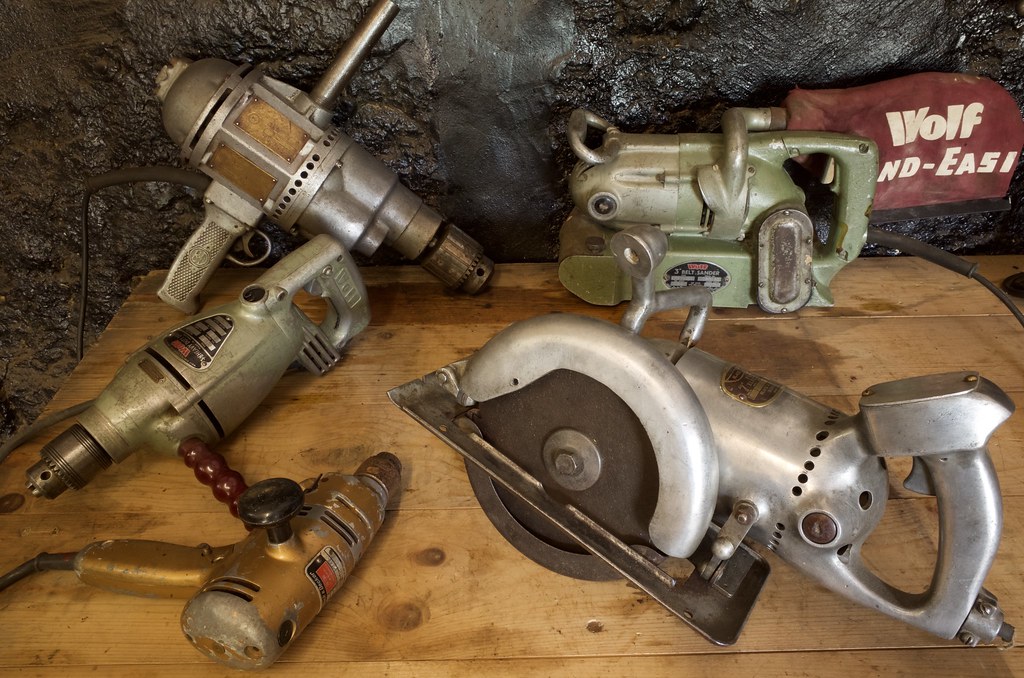Rhyolith
Established Member
I like to use old tools, mainly simply because they are more reliable and maintainable... each purchase with something made before ~ 1970 is for a lifetime rather than the next few years.
However when it comes to power tools I for a long time kept clear of anything secondhand (let alone stuff more than 10 years old). How things have changed.... :roll:
 Metal Bodied Powertools by Rhyolith, on Flickr
Metal Bodied Powertools by Rhyolith, on Flickr
I still get looks of horror when I say I use a belt sander from 1960 and several drills much older (1920s being the earliest i think).
However, the only powertool thats ever hurt me due to a fault (and consider i use the aluminium bodied tools a lot more than anything else now) was a plastic bodied B&D from the early 2000s... (it literally blew up!).
So this got me thinking, is the horrific reputation of metal bodied power tools actually earned?
The fact aluminium conducts electricity is probably the first thing that springs to mind when thinking about this and its one of the things that kept me off these things for a long time. However, if you think about it why would the electricity go through you? If there's an earth (which of course, there should be) then there is virtually no situation (to my knowledge) where a shock would go through you rather than the earth... Short of something really stupid like using the tool soaking wet or something #-o
Something else to consider is that, in my opinion most accidents caused by the tool itself (so not misses etc) are down to the tool failing physically, this was certainly the case with the aforementioned plastic drill. Its no secret that most of these older powertools and much better built than their modern counterparts (particularly makes like Wolf) so much less likely to fail.
Do you think metal bodied power tools are a death trap or is it just a theoretical risk that next to never actually happens? Maybe even the poor build quality of modern tools is actually more likely to harm you?
Thats a bit of a brain fart, but maybe it will interest someone.
However when it comes to power tools I for a long time kept clear of anything secondhand (let alone stuff more than 10 years old). How things have changed.... :roll:
 Metal Bodied Powertools by Rhyolith, on Flickr
Metal Bodied Powertools by Rhyolith, on FlickrI still get looks of horror when I say I use a belt sander from 1960 and several drills much older (1920s being the earliest i think).
However, the only powertool thats ever hurt me due to a fault (and consider i use the aluminium bodied tools a lot more than anything else now) was a plastic bodied B&D from the early 2000s... (it literally blew up!).
So this got me thinking, is the horrific reputation of metal bodied power tools actually earned?
The fact aluminium conducts electricity is probably the first thing that springs to mind when thinking about this and its one of the things that kept me off these things for a long time. However, if you think about it why would the electricity go through you? If there's an earth (which of course, there should be) then there is virtually no situation (to my knowledge) where a shock would go through you rather than the earth... Short of something really stupid like using the tool soaking wet or something #-o
Something else to consider is that, in my opinion most accidents caused by the tool itself (so not misses etc) are down to the tool failing physically, this was certainly the case with the aforementioned plastic drill. Its no secret that most of these older powertools and much better built than their modern counterparts (particularly makes like Wolf) so much less likely to fail.
Do you think metal bodied power tools are a death trap or is it just a theoretical risk that next to never actually happens? Maybe even the poor build quality of modern tools is actually more likely to harm you?
Thats a bit of a brain fart, but maybe it will interest someone.

































